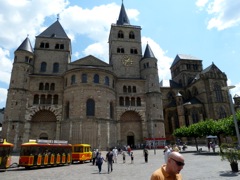
|
A following day we went to Trier. This is an ancient Roman town.
|

|
The Porta Nigra (latin: Black Gate) was the imposing city entrance the Romans made to inspire awe in the barbaric northern Germanic tribes. It dates from 200 AD.
|

|
Originally there were four such gates to the city. This is the only one remaining.
It was open between the towers.
|

|
After 1000 AD, the gate was remodeled into a church. That is why it was preserved.
In 1804, Napoleon ordered it restored.
|

|
However it was not unscathed. The sandstones were tied together by iron bars. The people dug some of them out to make tools.
|

|
We walked to this gorgeous plaza, and we had a Doner lunch.
|

|
Next: To the Trier cathedral. It is the oldest in Germany. (On the right is a separate, disconnected church.)
One tower is higher than the other. The church often struggled for political power with the secular government during history. When city hall was built higher than the cathedral, the archbishop had one of his towers raised to establish dominance.
|

|
The inside was incredibly full of expensive details: endless non-repeating artwork detail, expensive stone and other materials. It was made to impress: hopefully the greatness of God, but certainly of the power and wealth of the church!
|

|
The vault over the choir area.
|

|
Another 3D relief with many biblical scenes. Too much, I think.
|

|
Next, the Constantine Basilica: The emperor Constantine moved his throne from Rome to Trier for a few years. He sat in a raised dais in the rounded end of the building. Note that the windows on the left are smaller...
|

|
The windows created a forced perspective that made the throne more dramatic. Originally the brick was plastered and light colored. So the room was suffused with light.
It was rebuilt many times, and used for many things over the years. Now it is a church.
|

|
In back (attached) is the palace and gardens of the bishop of Trier. We walked through them (a park) to...
|

|
The Roman baths: a place of luxury for the rich with hot, lukewarm and cold waters. Also made of Roman brick. There were tunnels underneath for workers that made everything happen. Great for running exploration by the kids in our group.
|

|
Next: to the amphitheater: It seated 20,000. The Roman games here were a blood spectacle. Notice the stairs down in the middle of the field.
|

|
The arena also had a place for workers underneath to put on the show: lions being raised by machinery, etc.
|

|
On the way back we stopped at an overlook of the town of Cochem: a castle beside the winding Mosel river, vineyards. Very beautiful!
|